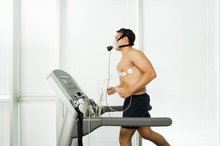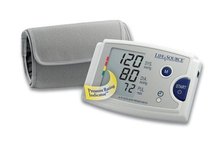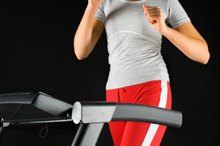What does fact checked mean?
At Healthfully, we strive to deliver objective content that is accurate and up-to-date. Our team periodically reviews articles in order to ensure content quality. The sources cited below consist of evidence from peer-reviewed journals, prominent medical organizations, academic associations, and government data.
- American College of Sports Medicine: Selecting and Effectively Using an Elliptical Trainer or Stair Climber
- American College of Sports Medicine: Selecting and Effectively Using an Elliptical Trainer or Stair Climber
- American Heart Association: Target Heart Rates
The information contained on this site is for informational purposes only, and should not be used as a substitute for the advice of a professional health care provider. Please check with the appropriate physician regarding health questions and concerns. Although we strive to deliver accurate and up-to-date information, no guarantee to that effect is made.
High Heart Rate on an Elliptical
Elliptical trainers offer a workout that is a little bit like cross-country skiing and a little bit like climbing stairs, so it's safe to say that after even a few minutes on the machine, your heart rate will rise and you'll start breathing heavier. Your heart rate is just one way that you can monitor the intensity of your workout, and on most elliptical trainers, you'll have the benefit of a heart rate monitor built right into the machine. If your heart rate seems to be really high during the workout, chances are it is; though it might not be as accurate as you might think.
Basics of Heart Rate
The heart rate numbers on the screen are going to be worthless without a little context. During exercise, the goal is to work at about 60 to 90 percent of your maximum heart rate, so the first step is to calculate what that maximum (MHR) is for you. There are more refined ways of calculating your MHR out there, but the simplest way is to subtract your age from 220. By that calculation, a 40-year-old's MHR would be roughly 180. With regular exercise, the heart gets more efficient at pumping blood, so the fitter person might have a slightly slower heart rate than that, while a totally sedentary person's MHR might be a bit faster.
- The heart rate numbers on the screen are going to be worthless without a little context.
- There are more refined ways of calculating your MHR out there, but the simplest way is to subtract your age from 220.
Averages on the Elliptical
Difference Between Gazelle Edge & Gazelle Freestyle
Learn More
Every elliptical trainer brand is slightly different, but on average, the intensity of the workout you'll get is about the same -- meaning you should expect a workout of similar intensity from machine to machine. Researchers at the University of New Mexico studied four different elliptical brands and found that participants' heart rates were roughly the same, hovering around 71 to 73 percent of each participant's MHR 3. Thus, the machines fell within the guidelines of the American College of Sports Medicine, which recommend people work out at about 60 to 90 percent of their MHR.
- Every elliptical trainer brand is slightly different, but on average, the intensity of the workout you'll get is about the same -- meaning you should expect a workout of similar intensity from machine to machine.
- Thus, the machines fell within the guidelines of the American College of Sports Medicine, which recommend people work out at about 60 to 90 percent of their MHR.
High Intensity Workouts
If you're working out on the elliptical trainer and you find that your heart rate is hovering around the 90 percent or higher mark, it's likely that you're pushing yourself very hard. Unless you've been informed by your doctor not to exercise at high intensity, it's OK to work out that hard, but chances are you won't be able to maintain that level for a long workout. A more feasible way to do it might be to try a form of high-intensity interval training (HIIT). These workouts involve doing about one to two minutes of exercise at 70 to 90 percent of your maximum exertion level, followed by one to two minutes of recovery at 40 to 50 percent of max. Doing the six to eight recommended rounds will result in a workout that is less than 30 minutes long. According to the IDEA Health & Fitness Association, you should only do HIIT about two to three days a week, so if you want to work out more than that, do longer workouts the other days at 60 to 70 percent of your MHR 4.
- If you're working out on the elliptical trainer and you find that your heart rate is hovering around the 90 percent or higher mark, it's likely that you're pushing yourself very hard.
- Unless you've been informed by your doctor not to exercise at high intensity, it's OK to work out that hard, but chances are you won't be able to maintain that level for a long workout.
Accuracy
What Happens During Exercise at 90% of Maximum Heart Rate?
Learn More
Keep in mind that the heart rate number you're seeing may not be entirely accurate for several reasons. Unless you've had your MHR tested by your doctor or an exercise physiologist, you may be under- or overestimating your MHR. The heart rate monitors on the elliptical may not be entirely accurate either. According to the National Council on Strength and Fitness, ellipticals typically overestimate calorie burn 5. Since the number of calories you burn is directly tied to your exertion level, it follows that most machines also misrepresent other values. Entering your weight, age and gender into the machine's computer may help get a more accurate reading, but still, take that number as only a very rough estimate. You don't need to concern yourself with the numbers that closely either. Your "rate of perceived exertion," basically how you feel, can be just as good. If you feel like you're working out hard, you probably are.
- Keep in mind that the heart rate number you're seeing may not be entirely accurate for several reasons.
- Since the number of calories you burn is directly tied to your exertion level, it follows that most machines also misrepresent other values.
Related Articles
References
- American College of Sports Medicine: Selecting and Effectively Using an Elliptical Trainer or Stair Climber
- American Heart Association: Target Heart Rates
- University of New Mexico: Elliptical Products
- IDEA Health & Fitness Association: HIIT vs. Continuous Endurance Training: Battle Of The Aerobic Titans
- National Council on Strength and Fitness: Elliptical Trainers Over Estimate Caloric Expenditure
- Hohmann E, Reaburn P, Tetsworth K, Imhoff A. Plantar Pressures During Long Distance Running: An Investigation of 10 Marathon Runners. J Sports Sci Med. 2016;15(2):254–262.
- Damiano DL, Norman T, Stanley CJ, Park HS. Comparison of elliptical training, stationary cycling, treadmill walking and overground walking. Gait Posture. 2011;34(2):260–264. doi:10.1016/j.gaitpost.2011.05.010
Writer Bio
Nicole Vulcan has been a journalist since 1997, covering parenting and fitness for The Oregonian, careers for CareerAddict, and travel, gardening and fitness for Black Hills Woman and other publications. Vulcan holds a Bachelor of Arts in English and journalism from the University of Minnesota. She's also a lifelong athlete and is pursuing certification as a personal trainer.









